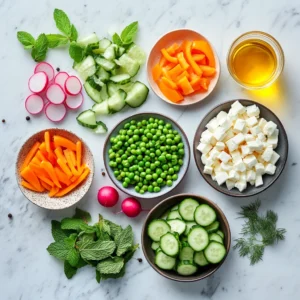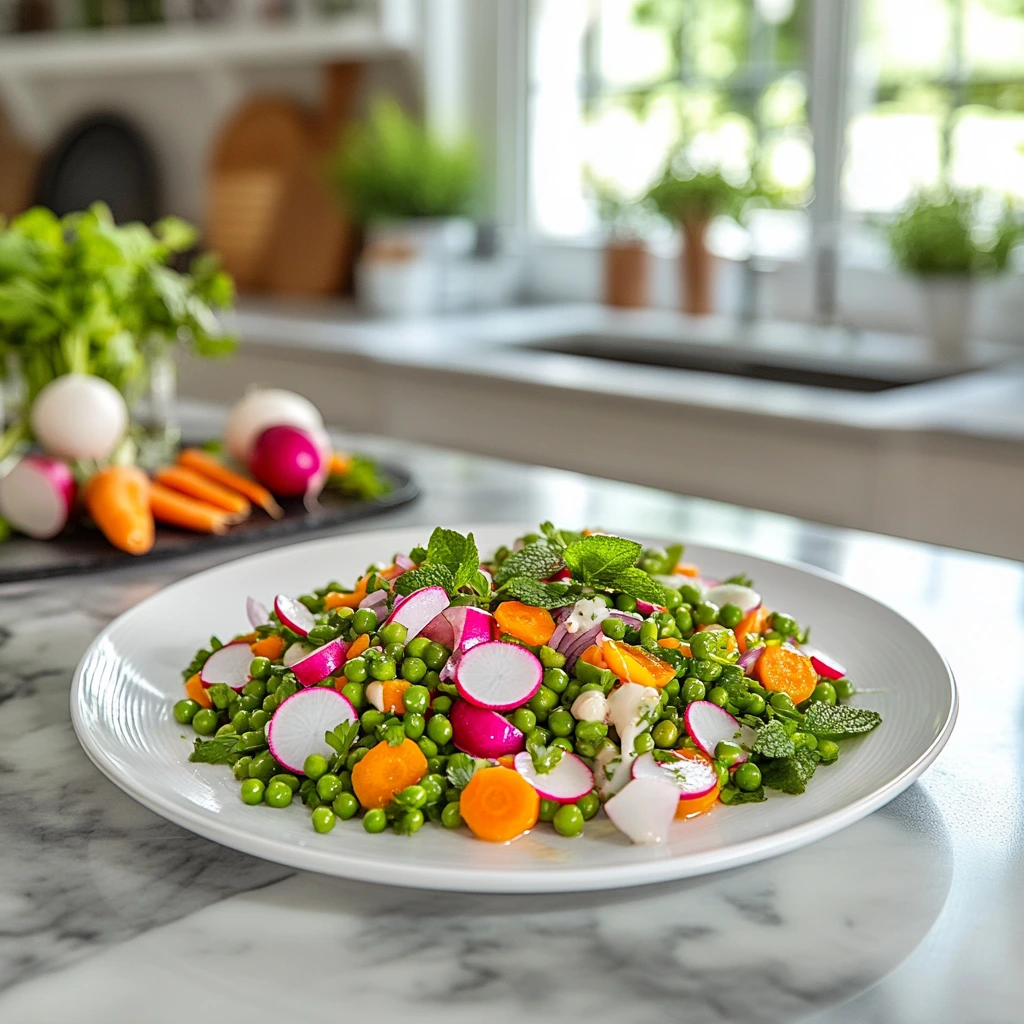Discover the refreshing world of pea salad with this comprehensive guide that not only explains the history and nutritional benefits of this delightful dish but also offers detailed instructions, creative variations, and expert tips for achieving a perfect balance of flavors. In this article, we present a complete guide that spans approximately 2000 words, designed to help you master the pea salad recipe while keeping the content structured with bullet lists for easy reading.
Introduction
The pea salad recipe is a vibrant and healthy dish that has earned its place on tables around the world. With its blend of fresh garden peas, crisp vegetables, and zesty dressings, it offers a delicious combination of taste and nutrition. Whether you are looking for a light side dish or a filling main course, pea salad stands out for its versatility and ease of preparation.
- Key Benefits:
- Light and refreshing for warm weather
- Suitable for various diets, including vegan and gluten-free
- Rich in essential nutrients, fiber, and antioxidants
- Can be made in advance for quick meals
For more recipe inspiration, check out our Chicken Orzo Recipe: A Hearty One-Pot Delight.
History and Background
Understanding the origins and evolution of the pea salad can add depth to your cooking experience. This dish has a long history and has been adapted by many cultures over time, making it a true culinary classic.
- Historical Origins:
- Originated in rustic European kitchens where simple, local ingredients were used
- Served as a light starter during family gatherings and festive occasions
- Evolved from a basic vegetable dish to a gourmet salad with international influences
- Cultural Significance:
- Celebrated in Mediterranean and European cuisines for its simplicity and nutritional value
- Frequently featured in seasonal menus as a celebration of fresh produce
- Recognized as a symbol of healthy, balanced eating throughout the decades
- Modern Evolution:
- Modern recipes incorporate a variety of ingredients such as cheeses, nuts, and diverse dressings
- Chefs now experiment with global twists, adding ingredients like quinoa, chickpeas, or even fruits
- The dish’s evolution mirrors the growing demand for healthy yet flavorful meal options
To explore more about nutritional eating and culinary traditions, visit EatRight.org.
Essential Ingredients Breakdown

Perfect Pea Salad
Equipment
- Chef’s Knife
- Cutting Board
- Mixing Bowl
- Fine Mesh Strainer
Ingredients
Main Ingredients
- 2 cups fresh or frozen peas blanched
- 1 cup carrots julienned or diced
- 1/2 cup radishes thinly sliced
- 1 cup bell peppers diced, red, yellow, or orange
- 1/2 cup cucumber diced
- 1/4 cup red onion or scallions finely chopped
Herbs and Seasoning
- 1 tbsp fresh mint chopped
- 1 tbsp fresh basil chopped
- 1 tbsp fresh dill chopped
- 1/2 tsp black pepper freshly ground
- 1/2 tsp salt
Dressing
- 2 tbsp extra virgin olive oil
- 1 tbsp fresh lemon juice
- 1 tsp Dijon mustard optional
Extras (Optional)
- 1/4 cup crumbled feta or goat cheese
- 1/4 cup toasted almonds or walnuts
Instructions
- Bring a pot of water to a rapid boil and add the peas. Cook for 2-3 minutes until bright green.
- Transfer peas to an ice bath to stop cooking. Drain and set aside.
- Dice all vegetables into uniform pieces. Add them to a large mixing bowl.
- Gently fold in the blanched peas, ensuring even distribution.
- Whisk together olive oil, lemon juice, black pepper, salt, and Dijon mustard for the dressing.
- Drizzle dressing over the salad and toss gently to coat.
- Refrigerate for 15-20 minutes before serving.
Notes
Nutritional Benefits of Pea Salad
A well-prepared pea salad is not only a feast for the eyes and palate but also offers numerous health benefits. Here’s why incorporating this dish into your diet is a smart choice:
- Vitamins and Minerals:
- Rich in vitamins A, C, and K, which support immune function and skin health
- Provides folate, essential for cell growth and repair
- Contains minerals such as iron, magnesium, and potassium for overall wellness
- High in Fiber:
- Aids in digestion and promotes a healthy gut
- Helps maintain stable blood sugar levels and supports weight management
- Contributes to a feeling of fullness, reducing the urge to snack on less nutritious options
- Protein-Packed:
- Offers a significant amount of plant-based protein
- Ideal for vegan and vegetarian diets seeking protein alternatives
- Supports muscle repair and overall body function
- Low in Calories:
- A light yet satisfying option for those on a calorie-controlled diet
- Allows for guilt-free indulgence without compromising on taste
- Perfect as a side dish or a main course in a balanced meal plan
- Antioxidant Rich:
- Helps fight oxidative stress and inflammation
- Contributes to long-term health and prevention of chronic diseases
Recipe Variations and Customizations

To keep your meals exciting and tailored to your taste, consider these creative twists on the classic pea salad recipe. Each variation adds a unique flavor profile while maintaining the salad’s healthy core.
- Global Inspirations:
- Mediterranean Twist:
- Add ingredients like olives, sun‑dried tomatoes, and a sprinkle of oregano
- Drizzle with a light vinaigrette enhanced by red wine vinegar
- Asian-Inspired:
- Incorporate sesame oil, soy sauce, and a touch of ginger
- Top with chopped scallions and toasted sesame seeds for an exotic flair
- Rustic Country Style:
- Mix in diced apples and walnuts along with a creamy yogurt dressing
- Perfect for a hearty family meal that balances sweet and savory notes
- Mediterranean Twist:
- Dietary Modifications:
- Vegan Option:
- Replace dairy cheese with avocado slices or a plant-based alternative
- Use agave syrup or maple syrup instead of honey for a vegan-friendly dressing
- Gluten-Free:
- Focus on fresh, unprocessed ingredients naturally free of gluten
- Ensure that any store-bought components, like dressings, are gluten-free certified
- Vegan Option:
- Creative Enhancements:
- Boost the protein content by adding cooked quinoa or chickpeas
- Experiment with different herbs such as cilantro or parsley to alter the flavor profile
- Try a different dressing, such as an avocado-lime blend or a tangy balsamic reduction, for variety
Expert Tips & Tricks for the Perfect Pea Salad
Achieving the perfect pea salad is an art that combines careful preparation, precise technique, and a creative touch. Here are some expert tips to elevate your salad to new heights:
- Balancing Flavors:
- Use freshly squeezed lemon juice to maintain a natural tartness
- Add a small amount of honey or mustard to create a balanced contrast between tart and sweet
- Season gradually and taste as you go to ensure optimal flavor balance
- Maintaining Texture:
- Avoid overcooking the peas to keep them crisp and vibrant
- Dice vegetables uniformly so that each bite delivers a consistent texture
- Add crunchy elements like nuts or seeds only at the end to preserve their texture
- Presentation:
- Serve the salad in a chilled bowl to enhance its refreshing qualities
- Garnish with extra fresh herbs and a sprinkle of nuts for added visual appeal
- Use a colorful mix of vegetables to create an eye-catching dish that invites indulgence
- Avoiding Common Pitfalls:
- Overmixing can cause the vegetables to break down—toss gently
- Do not add dressing too early if preparing in advance; store it separately until just before serving
- Monitor the seasoning levels as the salad rests, adjusting salt and pepper if needed
For additional tips on creating flavor combinations that work, visit our How to Combine Spices: A Comprehensive Guide.
Serving Suggestions and Pairings

A beautifully crafted pea salad can be enjoyed on its own or as part of a larger meal. Here are some creative ideas to inspire your presentation and pairing choices:
- Meal Ideas:
- Enjoy the salad as a refreshing side dish paired with grilled fish, chicken, or tofu
- Serve as a light yet satisfying lunch on its own or alongside a warm soup
- Ideal for outdoor picnics and casual gatherings where a healthy option is desired
- Beverage Pairings:
- Complement the dish with a chilled glass of white wine or sparkling water
- For a non-alcoholic option, serve with a refreshing lemonade or iced herbal tea
- Pair with other seasonal recipes to create a balanced meal
- Occasion Suitability:
- Perfect for casual family dinners, summer barbecues, or festive brunches
- Use creative plating techniques, such as layered salads or mason jar presentations, for visual appeal
- Consider adding seasonal fruits like berries or citrus segments for extra color and flavor
Storing and Leftover Tips
Proper storage can help you enjoy your pea salad over multiple meals without compromising its quality. Follow these tips to ensure that your salad stays fresh and flavorful.
- Storage Guidelines:
- Refrigeration:
- Place the salad in an airtight container to maintain freshness
- If possible, store the dressing separately to prevent sogginess
- Shelf Life:
- Consume within 24 hours for best texture and flavor
- If preparing in advance, combine ingredients just before serving
- Refrigeration:
- Leftover Ideas:
- Use leftover pea salad as a filling for wraps or sandwiches for a quick meal
- Toss the salad with additional greens to create a new, vibrant dish
- Mix with cooked grains like quinoa or rice for a hearty bowl meal
Frequently Asked Questions (FAQs)
Below are some common questions that many home cooks have when preparing the pea salad recipe. These FAQs are designed to clarify doubts and provide useful tips to ensure your dish turns out perfectly every time.
- Can I use frozen peas instead of fresh peas?
- Yes, frozen peas are a great alternative. Ensure they are thawed and drained properly to maintain the salad’s texture.
- How can I prevent the salad from becoming soggy?
- Blanch the peas for the right amount of time, drain all vegetables thoroughly, and add the dressing only just before serving.
- What are some good substitutes for missing ingredients?
- For cheese, consider using diced avocado or a dairy-free cheese alternative. If fresh herbs are unavailable, dried herbs can work, though adjust the quantity accordingly. Nuts and seeds can be toasted for added crunch if you need an extra texture element.
- How long will the pea salad keep in the refrigerator?
- It is best enjoyed within 24 hours. Beyond that, the vegetables may lose their crispness, and the dressing can make the salad soggy.
- Can I prepare this salad ahead of time?
- Yes, you can prep the vegetables and peas in advance. Store the dressing separately and combine all ingredients shortly before serving to preserve flavor and texture.
Conclusion
The pea salad recipe is an excellent example of how simple, fresh ingredients can be transformed into a nutritious and delicious dish. With its bright colors, refreshing flavors, and impressive versatility, this salad is perfect for any occasion—from a quick lunch to a festive dinner.
- Summary of Key Points:
- The recipe highlights the importance of selecting fresh ingredients and proper preparation techniques
- Detailed step-by-step instructions ensure a flawless outcome every time
- Creative variations allow you to customize the dish to suit your dietary needs and flavor preferences
- Expert tips and FAQs provide additional guidance for home cooks
- Final Thoughts:
- Embrace the simplicity and health benefits of this pea salad while exploring your own creative twists
- Enjoy the process of combining crisp vegetables with tangy dressings and vibrant herbs
- Share your version of the dish with family and friends, and feel free to experiment with new ingredients
We hope this guide has provided you with all the information you need to create a delicious, fresh, and healthy pea salad that becomes a staple in your recipe collection. Happy cooking, and enjoy every bite of this nutritious delight!

